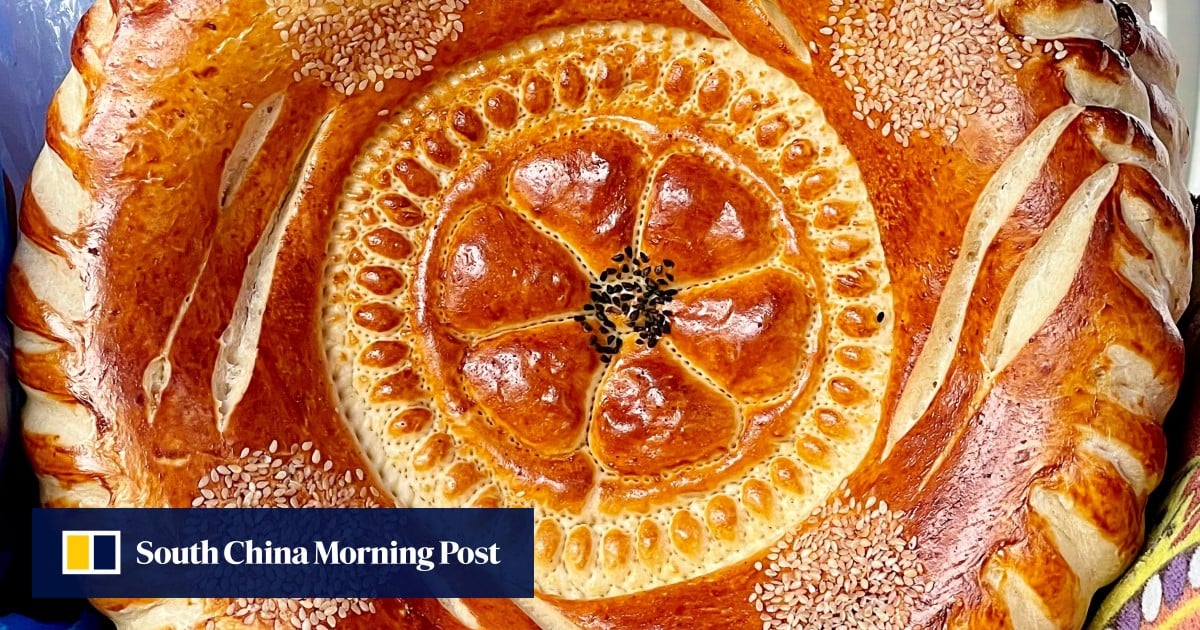Every village and town has its own varieties – differing in ingredients, weight, size, thickness, embossed patterns and, of course, names – but almost all are wheel-shaped.

Gala Osiyo bread – named after the Samarkand neighbourhood in which it is made – has a reputation for being long-lasting. It can be edible for up to three years – needing only to be sprayed with water and warmed up – and could therefore be carried on long trips along the ancient Silk Road.
The bread made in the Fergana Valley, in eastern Uzbekistan, is known for its intricate designs. This is not surprising as the area – although not a popular tourist stop – has been a hub of fine art and crafts for centuries.
In a small bakery at the Konigil Tourist Village – a quiet, leafy complex on the outskirts of Samarkand that is also the home of the Meros Paper Mill, which is powered by the waters of the Siab River – master baker Hofez Nuritdinnov mixes together wheat flour, water, salt and yeast. He then puts the dough to one side, where it will rise over several hours.
Bakers like Nuritdinnov are known as nonvoy. Their profession is highly respected and the skill is passed from father to son.
Given the long hours involved and the physical strength required to prepare dough and then make hundreds or thousands of loaves, nonvoy have traditionally been men.

Nuritdinnov, however, is assisted by his daughter-in-law, Nargiza Shodieva, who is in her early 30s. She cuts the dough into smaller portions before weighing each piece. She then rolls the dough into balls and sets them on a tray, to rest.
From another tray, Shodieva picks up a ball of dough, places it on the table and shapes it as a near-flat circle with slightly elevated sides. Then, using a spiked tool – known as a chekich in Uzbek, and a nonpar in Tajik, a language widely spoken in this part of Uzbekistan – she perforates the depression in the centre of the shaped dough. These indentations allow steam to escape during the baking process.
Shodieva repeats the process until the entire batch is ready.
Designs stamped on the bread at this stage identify one baker’s product from others.
“Historically, designs were used to make the bread more attractive,” Fatyan says. “They symbolised fertility, wealth or prosperity.”

Nowadays, some breads are stamped with the baker’s personal information, such as his name or even phone number.
Shodieva lubricates the base of the shaped dough with water and slaps each piece onto the inside of a vertical, wood-fired clay oven known as a tandir. Next, she carefully splashes some water inside the oven.
“Humidity is very much needed,” explains Anvar Nasimov, a Samarkand travel guide, to watching tourists. “It’s important for the tandir to be not too dry.”
The bread needs only a few minutes to turn a rich, golden hue. “[Shodieva] will know when the non is ready based on the colour,” Nasimov says.

Baked non have a crispy base and a thin crusty layer on the top. They are soft and fluffy on the inside. Samarkand bread tends to have a glazed crust and a dense interior, so is shinier and heavier than that from Tashkent, for example.
The taste of Samarkand’s bread is known to be irreplicable in other parts of the country, even if ingredients are sourced from the city. Fatyan attributes this to Samarkand’s good air and water.
Non has immense social and cultural significance for the Uzbek people.
“In the old days, before a man set out on a long journey, he would take a bite out a loaf of bread and the family would hang the rest of the loaf on a wall, waiting for his return,” Fatyan says.
She adds that bread plays an important role in other life events. Forty days after a birth, a ceremony is conducted to mark the moment when a baby is placed in its cradle. “At this ceremony, bread is placed in the cradle, as a symbol of wealth and a happy life,” she explains.
When a couple gets engaged, a single loaf is broken and shared between the two families. “From that day onwards, the two families become one,” Fatyan says.

When visiting someone on a happy occasion, it is traditional for a guest to arrive with two loafs of bread as a gift, which is indicative of abundance.
“But when visiting to offer condolences, you must bring one loaf only as the family is incomplete,” Fatyan says. “These numbers are very important.”
It is considered disrespectful to lay a loaf face down on a table and bread is never cut with a knife – it is always torn by hand. Children are taught to pick up bread dropped on the floor and place it aside for the birds.
“Bread is so precious for Uzbeks that they try to save every crumb,” Toshnazarov says.
As Shodieva sets a table for the tourists with freshly baked fatir (a flaky, layered bread), home-made strawberry jam, dates and tea, Fatyan says, “You can’t experience the culture of Uzbekistan without visiting a bakery.”

